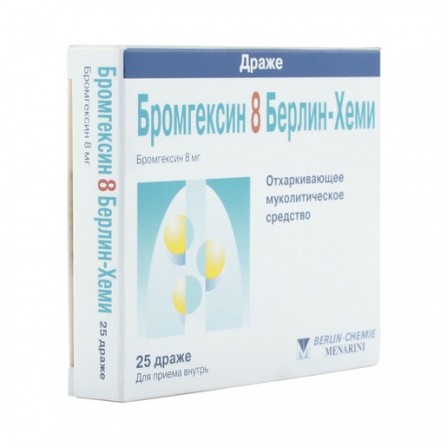Bromhexine Berlin-Chemie Bean 8mg N25
Condition: New product
1000 Items
Rating:
Be the first to write a review!

More info
Active ingredients
Bromhexine
Release form
Dragee
Composition
1 tablet: Bromhexine hydrochloride 8 mg. Adjuvants: lactose monohydrate - 34.4 mg, corn starch - 14.6 mg, gelatin - 1.8 mg, colloidal silicon dioxide - 0.6 mg, magnesium stearate - 0.6 mg. Shell composition: sucrose - 27.704 mg, calcium carbonate - 4.326 mg, magnesium carbonate - 1.507 mg, talc - 1.507 mg, macrogol 6000 - 1.75 mg, povidone C25 - 0.243 mg, glucose syrup - 1.639 mg, carnauba wax - 0.012 mg, titanium dioxide (E171) - 1.166 mg, quinoline yellow (Е104) - 0.146 mg.
Pharmacological effect
Mucolytic agent with expectorant action. Reduces the viscosity of bronchial secretions due to the depolarization of the acidic polysaccharides contained in it and stimulation of the secretory cells of the bronchial mucosa, producing a secret containing neutral polysaccharides. Bromhexine is believed to contribute to the formation of surfactant.
Pharmacokinetics
Bromhexine is rapidly absorbed from the gastrointestinal tract and is extensively metabolized during the first passage through the liver. Bioavailability is about 20%. In healthy patients, Cmax in plasma is determined after 1 hour. It is widely distributed in body tissues. About 85-90% is excreted in the urine mainly in the form of metabolites. Bromhexine metabolite is Ambroxol. Bromhexine binding to plasma proteins is high. T1 / 2 in the terminal phase is about 12 hours. Bromhexine penetrates the BBB. In small quantities penetrates the placental barrier. Only small amounts are excreted in the urine with a T1 / 2 6.5 hours. The clearance of bromhexine or its metabolites may decrease in patients with severe impaired liver and kidney function.
Indications
Diseases of the respiratory tract, accompanied by the formation of viscous secretion difficult to separate: tracheobronchitis, chronic bronchitis with a broncho-obstructive component, bronchial asthma, cystic fibrosis, chronic pneumonia.
Contraindications
Hypersensitivity to Bromhexine.
Precautionary measures
Do not exceed recommended doses.
Use during pregnancy and lactation
During pregnancy and lactation, Bromhexine is used in cases where the intended benefit to the mother outweighs the potential risk to the fetus or child.
Dosage and administration
Inside adults and children over 10 years old - 8 mg 3-4 times / day.Children under 2 years old - 2 mg 3 times / day; at the age of 2 to 6 years, 4 mg 3 times / day; between the ages of 6 and 10 years, 6–8 mg 3 times / day. If necessary, the dose can be increased to adults up to 16 mg 4 times / day, children - up to 16 mg 2 times / day. In the form of inhalations for adults - 8 mg each, children over 10 years old - 4 mg each, at the age of 6-10 years - 2 mg. At the age of 6 years - used in doses up to 2 mg. Inhalations are carried out 2 times / day. The therapeutic effect may occur 4-6 days of treatment. Parenteral administration is recommended for treatment in severe cases, as well as in the postoperative period to prevent the accumulation of thick sputum in the bronchi. Enter 2 mg p / c, in / m or / in 2-3 times / day slowly over 2-3 minutes.
Side effects
On the part of the digestive system: dyspeptic phenomena, transient increase in the activity of hepatic transaminases in the serum.
Overdose
Symptoms: headache, nausea, vomiting. Treatment: symptomatic. There is no specific antidote.
Interaction with other drugs
Bromhexine is incompatible with alkaline solutions.
special instructions
In case of gastric ulcer, as well as indications of gastric bleeding in the history of bromhexine should be used under the supervision of a physician. Use with caution in patients suffering from bronchial asthma. this makes it difficult to cough up diluted sputum. It is used as part of combination preparations of plant origin with essential oils (including eucalyptus oil, anise oil, peppermint oil, menthol).




